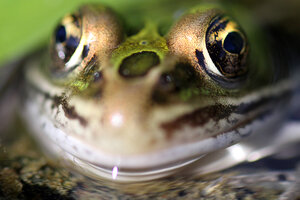New leopard frog species calls New Jersey's I-95 corridor home
DNA and mating croaks helped confirm the Atlantic Coast leopard frog a distinct species. It has survived in one of the most heavily populated areas on Earth, showing that even in urban areas, new species crop up.

A frog peers out from the edge of a pond, in Brainerd, Minn., Aug. 11, 2011.
Kelly Humphrey/Brainerd Dispatch/AP/File
For some 250 years, an enigmatic frog found initially in wetlands in the New York-New Jersey metro area has endured an identity crisis, lumped in with look-alike species of leopard frogs in the region.
It now has a name of its own – the Atlantic Coast leopard frog, or Rana kauffeldi – only the second new species of frog or toad researchers have discovered on the continental US in nearly 30 years.
The frog's identity crisis was resolved by a team of researchers from five universities and the New Jersey Division of Fish and Wildlife, with additional leg work provided by volunteers with the US Geological Survey's North American Amphibian Monitoring Project.
Together, they have compiled a picture of a species that has survived as the dominant species of leopard frog in one of the most heavily populated locations on Earth, with hints that others of its kind appear along the I-95 corridor from southeastern Massachusetts to northeastern North Carolina.
Uncovering R. kauffeldi's unique identity will allow scientists to compare it with museum specimens as well as frogs in the field to identify its range and habitat needs. Such information would help determine the any conservation requirements for the species.
The study, published this week in the online journal PLOS One, also underscores the point that even in urban areas, new species crop up – local discoveries with global implications.
“If there is a single lesson to take from this study, it’s that those who love nature and want to conserve it need to shut down their computers, get outside, and study the plants and animals in their own backyards,” Brad Shaffer, an evolutionary biologist at the University of California at Los Angeles and a member of the research team, said in a statement.
In the end, the goal is to preserve Earth's biodiversity, said Dr. Shaffer, who along with Louisiana State University PhD student Catherine Newman conducted the genetic analyses that help establish R. kauffeldi's bona fides as a distinct species.
This is particularly challenging for amphibians, whose numbers are falling for reasons ranging from habitat destruction and disease to invasive species. Amphibian decline is considered one of the most high-profile threats to biodiversity so far.
Leopard frogs in the northeastern US are no exception, says Jeremy Feinberg, a PhD student in biology at Rutgers University and the lead author of the paper laying out the case for the new species designation.
Indeed, the work began with Mr. Feinberg's research into the disappearance of southern leopard frogs on Long Island.
“These frogs basically vanished from Long Island by 2000,” he says. His hunt for sites with abundant frogs to help with the study ultimately led him to the wetlands of western Staten Island.
On his second trip there, during a rainstorm, male frogs were serenading females, but the sound of the croaking was not what Feinberg expected to hear from southern leopard frogs, he recalls.
“I come out of the swamp basically scratching my head and thinking: What the heck is going on?” he says.
It took two more years to find geneticists who were willing to help identify the sources of the rainy-evening serenade.
Although the Atlantic Coast leopard frog has long been a fixture in the region's wetlands, its standing as a unique species has been shaky. Its form and markings are easily confused with two related species to the north and south of the New York-New Jersey metro area.
The first try at establishing R. kauffeldi as a distinct species came in 1936, when herpetologist Carl Duffel proposed that the region hosted three species of leopard frog, rather than two. But it was a tough sell.
One approach to identifying frog species is by comparing mating calls. R. kauffeldi's mating croak, however, has a relatively low pitch, making it harder to hear. Moreover, its habitat had been chopped up. It calls at irregular intervals during a brief mating season, which comes with the first mild temperatures in March. And its mating season is short. These factors would have conspired against naturalists trying to sort among species via sounds. And the visual similarities among the leopard-frog species also confused the issue.
In 2012, the team published initial results from genetic studies indicating that the frog represented a new species. But they didn't have enough information to describe it more thoroughly and establish its relationship to other leopard-frog species in the region.
For this latest study, the researchers used voice-print technology to compare their subject's mating calls to those of related species. In addition, Yale biologist Gregory Watkins-Colwell carefully measured more than 500 museum specimens of leopard frogs from the region to tease out the differences in physical structure between northern, southern, and Atlantic Coast leopard frogs. And the team used additional genetic information to fill out R. kauffeldi's qualifications to be viewed as a unique species.
With help from the USGS's amphibian monitoring program, the team found that R. kauffeldi is the dominant leopard-frog species in a region that covers coastal Connecticut, southeastern New York state, northern New Jersey, and portions of New Jersey, Pennsylvania, and Delaware that lie along the Delaware River; as well as a tiny patch of northeastern Maryland. But its presence also extends along much of the eastern seaboard.

